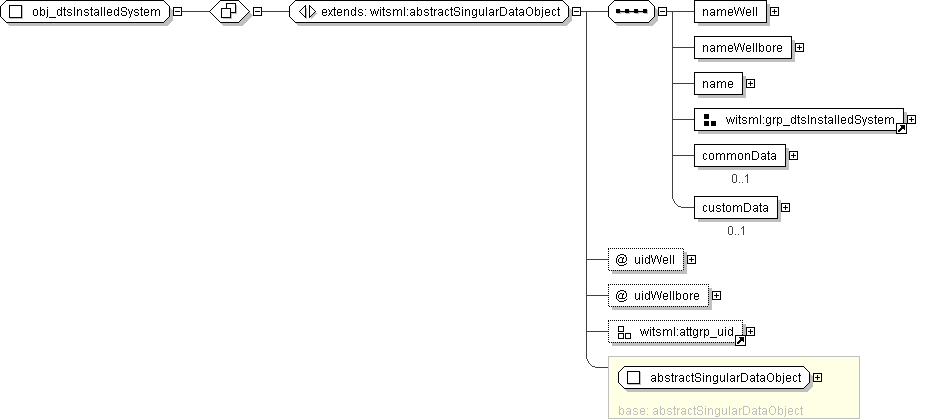
| Super-types: | abstractSingularDataObject < obj_dtsInstalledSystem (by extension) |
|---|---|
| Sub-types: | None |
| Name | obj_dtsInstalledSystem |
|---|---|
| Used by (from the same schema document) | Complex Type obj_dtsInstalledSystems |
| Abstract | no |
'Unique identifier for the well. This uniquely represents the well referenced by the (possibly non-unique) nameWell.'
"'Unique identifier for the wellbore. This uniquely represents the wellbore referenced by the (possibly non-unique) nameWellbore.'
"'The unique identifier of a container element. This attribute is generally required within the context of a WITSML server. There should be no assumption as to the semantic content of this attribute. This should only be used with recurring container types (i.e., maxOccurs greater than one). The value is only required to be unique within the context of the nearest recurring parent element.'
">'Human recognizable context for the well that contains the wellbore.'
'Human recognizable context for the wellbore that contains the installed system.'
'The minimum date index contained within the object. The minimum and maximum indexes are server query parameters and will be populated with valid values in a \"get\" result. That is, all measurements for a well in the specified period defined by the min/max. See the WITSML API Specification appendix on \"Special Handling\" of growing objects for a description of the behavior related to this parameter.'
'The maximum date index contained within the object. The minimum and maximum indexes are server query parameters and will be populated with valid values in a \"get\" result. See the WITSML API Specification appendix on \"Special Handling\" of growing objects for a description of the behavior related to this parameter.'
'The definition of the \"current date\" index for this object. The current date index is a server query parameter which requests the selection of a single node from a recurring set (e.g., the data related to one point in a date series). That is, the \"most recent\" (at or before the specified date) installation for a well. See the WITSML API Specification appendix on \"Special Handling\" of growing objects for a description of the behavior related to this parameter.'
'Contextual data about the well in which the system was installed.'
'Is this a planned installation in a well, or has the installation already occurred. Note that the default value is \'false\', which states that this is an actual installation.'
'Information about the fiber used, and its installation.'
'Information about the instrument box used, and its installation.'
'The configuration of the fiber installation. Example values would be linear, linear with gauge, J, U.'
'A fiber installed with a \"U\" configuration will have two ends available for hookup to an instrument box. In order to record which end is cabled to the instrument box on a particular measurement run, it is necessary to identify the two ends. This complex type allows a name and description for each end, so that it may be identified in a later use. This may also be useful when multiple fibers in multiple wellbores converge at the same wellhead.'
'The length of the fiber installed in the wellbore.'
'A table of values along the length along the fiber.'
'Total light budget available for the installation. This is generally measured in decibels, and indicates the total power loss for two-way travel of the light in the installed fiber.'
'The activity of pumping the fiber downhole'
'This captures the data from the pre-installation and post-installation OTDR tests run on the fiber. A standard quality control program would include these two, but the schema allows for more than two if additional runs associated with the installation of the fiber are performed. OTDR runs associated with a measurement are given as a child of the measurementInformation element.'
'Any calibration other than the ones explicitly given may be recorded here. This is a general calibration type, which is populated with name/value pairs.'
'If an instrument box is changed, for example, but the fiber remains the same, this instance of installed fiber is given to record that change. This element refers to a previous installed fiber, on which this one is based. For example, the wellboreFiberSchematic is unchanged, and may be obtained from the previous instance of installed fiber that is referenced here.'
'A container element that contains elements that are common to all data objects.'
'A container element that can contain custom or user defined data elements.'
